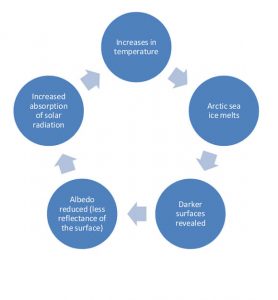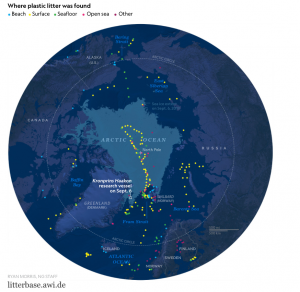Microplastics in the Arctic
What are Microplastics?
Microplastics are plastic particles that are smaller than five millimeters and it is one of the most serious pollutants in the Arctic along with other pollutants that are mentioned on this website (Black carbon, Mercury, and POPs). One of the biggest challenges about Microplastics is that they do not biodegrade and it takes up to several hundred years to decompose completely. Moreover, Microplastics in the Arctic are expected to increase rapidly due to Climate Change, which further leads to the intensification of melting of sea ice as well as fishing and shipping activities.
Impact of Microplastics in the Arctic
1. Ecosystem
Little organisms that are living in the sea ice, such as algae are, cannot differentiate between food and microplastics. As they consume plastic particles and being eaten by other creatures, it would harm the higher levels in the polar food chain.

2. Human Health
Microplastics can enter the human body through both eating and breathing. Research has shown that microplastics can penetrate human tissues, and airborne microplastics can lead to cancerous human lung tissue.
3. Melting/Formation of Sea Ice
Microplastics could impact the absorption of solar radiation, which further affects Albedo. Albedo is the amount of sunlight that is reflected by the surface. Plastic products that are dyed or painted absorb light, which further leads to an increase in the absorption of light. This would decrease surface albedo, which means it reflects less heat into the atmosphere and causes an increase in surface temperature.

Why Are There So Many Microplastics in the Arctic?
A recent study, Global patterns of marine micro-particles, demonstrated that concentrations of microplastics were higher in the Arctic Basin than all other ocean basins. As seen in the map below, one of the most plastic-polluted parts of the Arctic is found in the deep-sea sediments in the Fram Strait. There are two reasons why many Microplastics are found in this region, which is explained below.


Reason 1: Sea Ice
The high volumes of sea ice transported from the Arctic Ocean via the Fram Strait are a potential source. Sea Ice not only transports but also stores massive amounts of microplastics. Thus, as sea ice melts due to the warm climate, these plastic particles are released into the water. As they get released, they accumulate on the deep-sea sediments.
Reason 2: Currents Two main ocean currents in Fram Strait (WSC and EGC) could also be a potential source that transports the microplastics into the region from both the Arctic and the North Atlantic.
Two main ocean currents in Fram Strait (WSC and EGC) could also be a potential source that transports the microplastics into the region from both the Arctic and the North Atlantic.
Who Is Engaged in Research?
The research on Microplastics in the Arctic is an ongoing project. Many of the working groups of the Arctic Council are involved, which includes AMAP (Arctic Monitoring And Assessment Program), PAME (Protection of the Arctic Marine Environment), and CAFF (Conservation of Arctic Flora and Fauna). AMAP, for instance, established the expert groups that would be focusing on Litter and Microplastics in the Arctic. This expert group will be designing and developing necessary guidelines and monitoring programs.
Challenges/Limitation
Separating other particles from microplastics is very difficult, especially with Black Carbon. Due to this challenge, current measurements do not account for the presence of microplastics.
Policy Recommendations
Recommendation 1: Promote awareness on the understanding of the microplastic pollution issue on both the regional and the international level
This could happen through educating different communities and industries (particularly on the fishing and tourism industries) on the economic, health, and environmental threats from plastic pollution. One option could be hosting different workshop activities, particularly towards shipping, tourism, and oil extraction industries.
Recommendation 2: Development and implementation of a plastic waste prevention and removal policy and legislation
This could be achieved by partnering with industry and innovators as well as different Indigenous groups to actually prevent plastic from polluting the environment. The current policy effort led by AMAP’s Expert Group only focuses on designing and developing a monitoring method. In other words, it does not focus on the actual creation and implementation of microplastic prevention and removal legislation. This could be created through a knowledge-sharing platform that includes different Indigenous groups, industries, and innovators.
[ensemblevideo version=”5.6.0″ content_type=”video” id=”686aa757-6fed-4b03-bf34-daa632d0c161″ width=”848″ height=”480″ displaytitle=”true” autoplay=”false” showcaptions=”false” hidecontrols=”true” displaysharing=”false” displaycaptionsearch=”true” displayattachments=”true” audiopreviewimage=”true” isaudio=”false” displaylinks=”true” displaymetadata=”false” displaydateproduced=”true” displayembedcode=”false” displaydownloadicon=”false” displayviewersreport=”false” embedasthumbnail=”false” displayaxdxs=”false” embedtype=”responsive” forceembedtype=”false” name=”Microplastics in the Arctic “]
